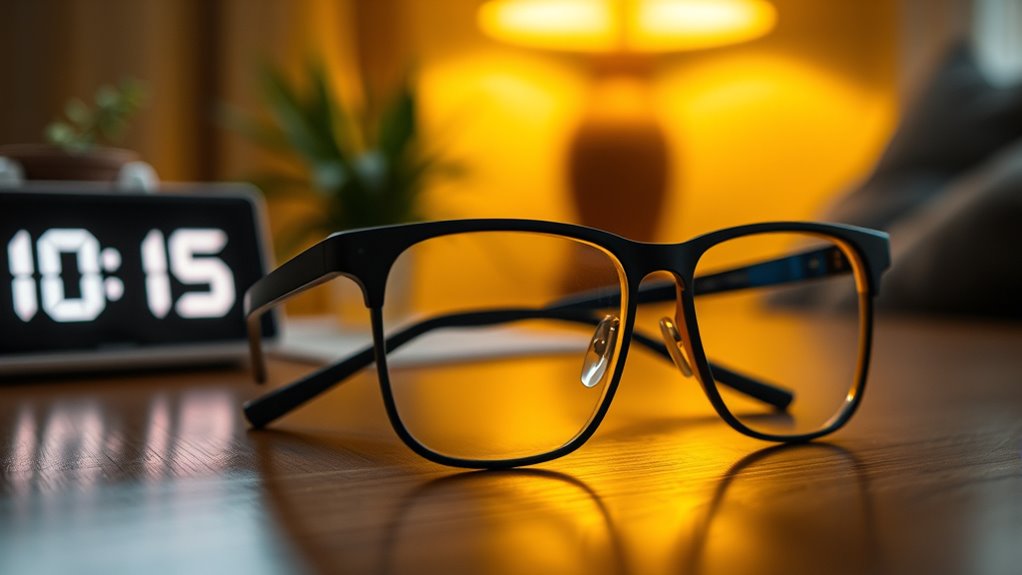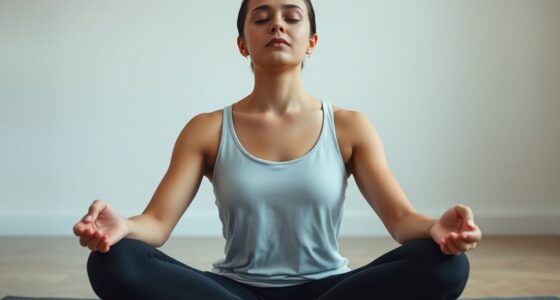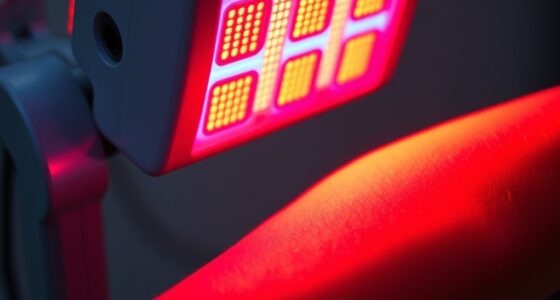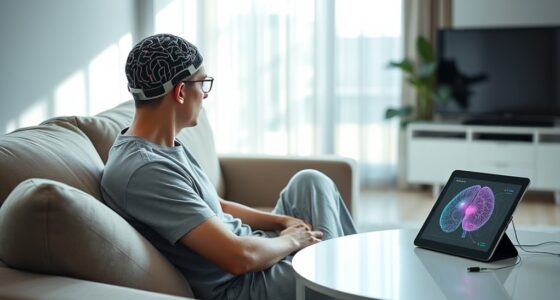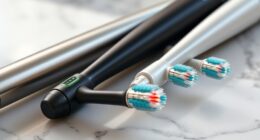Blue‑blocking glasses help support your circadian alignment by filtering out blue light that suppresses melatonin, making it easier to wind down and fall asleep. They reduce exposure during evening screen time, which often disrupts your sleep-wake cycle. Studies show they can improve sleep quality and help reset your internal clock. If you want to understand how these glasses can enhance your sleep routine and overall health, there’s more to discover below.
Key Takeaways
- Blue-blocking glasses reduce blue light exposure, supporting melatonin production and aiding circadian rhythm synchronization.
- Wearing these glasses in the evening helps prevent blue light-induced circadian disruption.
- They can improve sleep onset and quality by aligning internal clocks with natural light cycles.
- Evidence suggests blue-blocking glasses are effective for circadian entrainment, especially when used during evening screen time.
- Proper use alongside other sleep hygiene practices enhances circadian alignment and overall sleep health.
Understanding Blue Light and Its Impact on Sleep
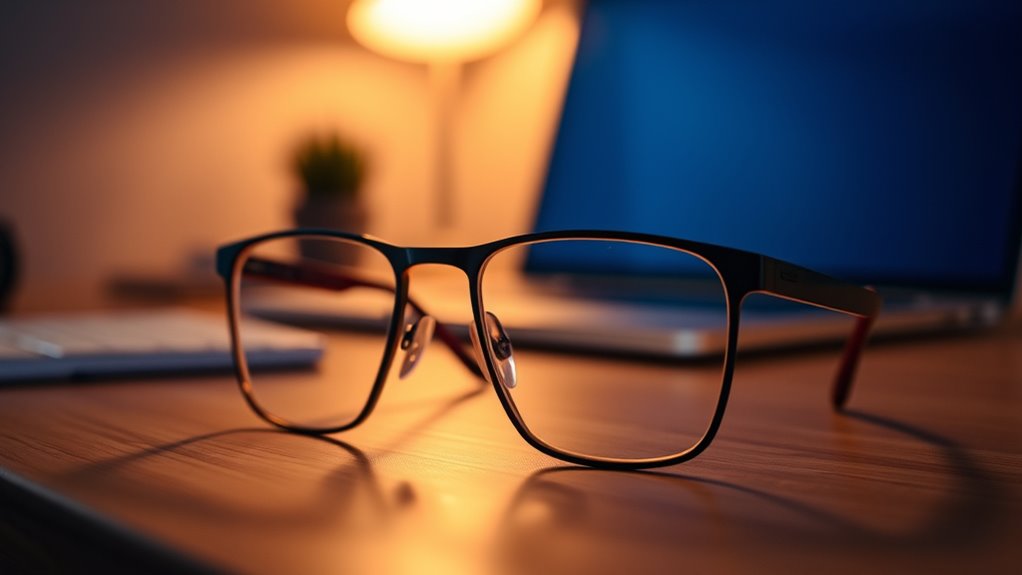
Blue light, a high-energy wavelength emitted by screens and digital devices, can substantially affect your sleep patterns. With increasing light pollution from urban areas and technological advancements, you’re exposed to more artificial blue light than ever before. This exposure disrupts your circadian rhythm by inhibiting melatonin production, making it harder to fall asleep and stay asleep. As screens become more integrated into daily life, understanding blue light’s impact is vital. The pervasive presence of artificial blue light from digital devices extends beyond natural sources, intensifying its influence. Recognizing how light pollution and modern technology contribute to sleep disturbances helps you take steps to protect your sleep health. Managing blue light exposure is essential for maintaining your circadian alignment and overall well-being. Additionally, some research suggests that antioxidants can help mitigate oxidative stress caused by light exposure, supporting your overall health. Being aware of light pollution and its effects can further help you minimize unintended exposure and safeguard your sleep quality. Incorporating blue light filters on your devices can also be an effective way to reduce exposure during evening hours.
How Blue-Blocking Glasses Work
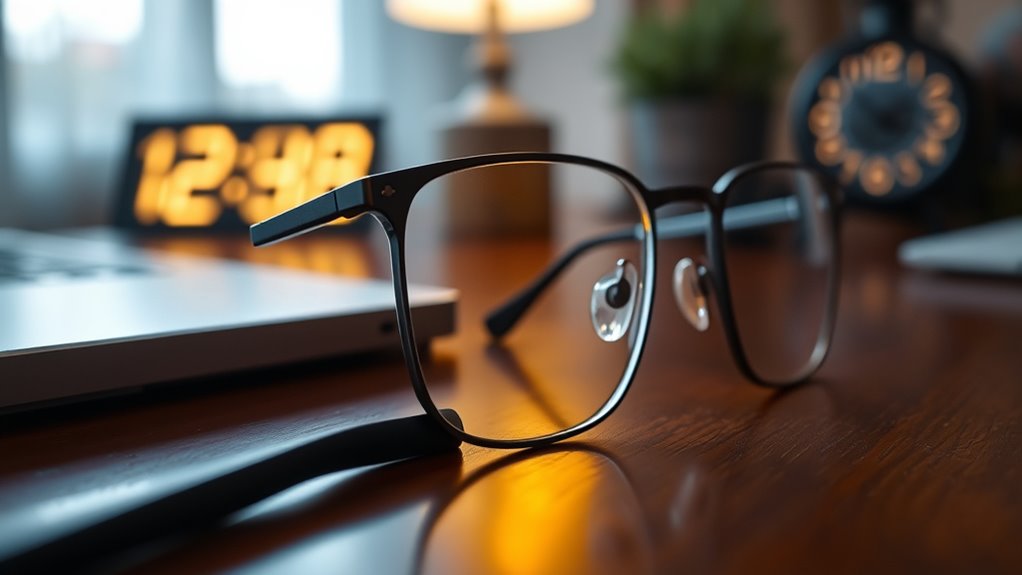
Blue-blocking glasses work by filtering out specific wavelengths of blue light from your environment. This reduces the amount of light that suppresses melatonin, helping your body prepare for sleep. As a result, you can experience better sleep quality and less eye strain. Additionally, understanding how AI safety measures are being developed highlights the importance of robust safety measures in emerging technologies. Incorporating high-quality projector calibration techniques can further enhance visual comfort and accuracy when viewing screens. For example, leveraging best anime movies can provide relaxing visual entertainment that minimizes eye strain during screen time.
Light Spectrum Filtering
These glasses work by selectively filtering out specific wavelengths of light within the visible spectrum, primarily those associated with blue light. This spectral filtering reduces the amount of blue light reaching your eyes, affecting how your brain perceives day and night signals. Through light modulation, they block or attenuate high-energy wavelengths that can disrupt your circadian rhythm. The filtering process targets the blue spectrum while allowing other wavelengths to pass, maintaining natural color perception. Additionally, the materials used in eco-friendly options often incorporate advanced technology to optimize light filtering efficacy. This targeted filtering helps in minimizing blue light exposure, which is linked to sleep disruption and eye strain. Incorporating quality lens coatings can further enhance filtering performance and durability.
Melatonin Suppression Reduction
By filtering out specific wavelengths of light, blue-blocking glasses help prevent the suppression of melatonin, the hormone responsible for regulating sleep. They reduce the activation of photoreceptor sensitivity in your eyes, mainly the light-sensitive cells that respond to blue wavelengths. When exposed to blue light during the evening, these photoreceptors send signals that delay the melatonin timeline, making it harder to fall asleep. Wearing blue-blocking glasses minimizes this effect, allowing melatonin levels to rise naturally in the evening. This supports your circadian rhythm, helping your body maintain its internal clock. By decreasing blue light exposure, you help preserve normal melatonin production and improve sleep quality, especially when using screens or artificial lighting at night. Additionally, understanding light exposure and its impact on sleep can guide effective strategies for circadian alignment, especially considering recent AI discoveries that could influence future health interventions. Recognizing the importance of Vetted information ensures that your sleep health strategies are based on reliable data.
The Science Behind Circadian Rhythms

Circadian rhythms are the body’s natural internal clock that regulates sleep-wake cycles and other physiological processes over a roughly 24-hour period. Your body relies on light signals to synchronize these rhythms, a process known as circadian entrainment. When exposed to natural light, especially in the morning, your brain signals melatonin production to decrease, helping you stay awake. Conversely, in the evening, reduced light triggers melatonin release, making you feel sleepy. Disruptions in light exposure can throw off this delicate balance, leading to sleep issues. Understanding the science behind circadian rhythms shows how light influences biological processes, highlighting why managing light exposure—like using blue-blocking glasses at night—can support healthier circadian entrainment and overall sleep quality. AI security technologies are increasingly being explored to monitor and optimize light exposure patterns for better health outcomes. Additionally, individual differences, such as regional light exposure and lifestyle, can influence how effectively your circadian system adapts. Recognizing the role of personalized light management can further enhance strategies to maintain optimal circadian health.
Research Studies on Blue-Blocking Glasses and Sleep Quality

Recent research demonstrates that wearing blue-blocking glasses can considerably improve sleep quality by reducing exposure to blue light in the evening. Studies show that blue light from screens causes sleep disruption by suppressing melatonin production, making it harder to fall asleep and stay asleep. In controlled experiments, participants who wore blue-blocking glasses before bedtime reported better sleep quality, increased sleep duration, and more restorative sleep stages. These findings suggest that blocking blue light in the evening minimizes its negative impact on your circadian rhythm. By limiting blue light exposure, you can reduce sleep disruption and promote healthier sleep patterns. Overall, research supports blue-blocking glasses as an effective tool for improving sleep quality, especially for those who use electronic devices late at night. Incorporating sound design techniques such as ambient sounds and audio cues can also enhance sleep environments and further support circadian health. Additionally, using blue-light filtering glasses can protect your eyes from potential strain caused by prolonged screen time.
Practical Use Cases for Blue-Blocking Glasses
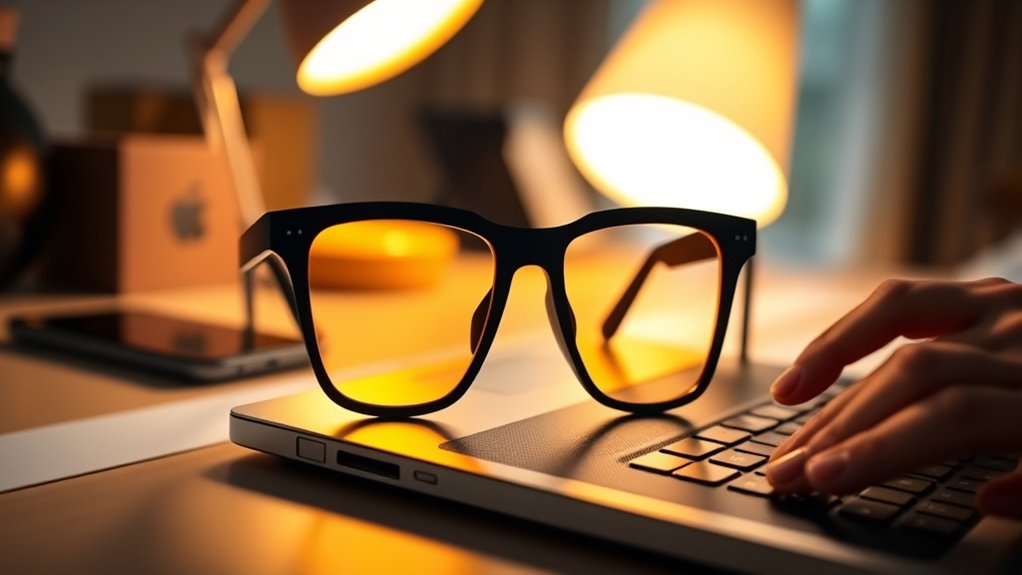
You can wear blue-blocking glasses during evening screen time to reduce blue light exposure and improve sleep. If you work night shifts, these glasses might help minimize circadian disruption. They’re also useful for relaxing before bed, signaling to your body that it’s time to wind down. Incorporating these glasses into internal company hackathons can foster healthier routines among participants and promote overall well-being. Using blue-blocking glasses is supported by research indicating that they can influence circadian rhythms positively, which is especially important for maintaining independent living and quality of life for seniors.
Evening Screen Time
As evening approaches and screens become a part of your nightly routine, blue-blocking glasses can help reduce the impact of blue light exposure. When you use screens during this time, blue light can interfere with your circadian rhythm, leading to sleep disruption. Wearing blue-blocking glasses helps filter out the blue wavelengths, minimizing their effect on your melatonin production. This makes it easier to wind down and signals that it’s time to sleep. If you often watch TV, scroll through your phone, or work on a computer in the evening, these glasses can be a simple yet effective tool. By limiting blue light exposure, you support better sleep quality and help your body prepare for restful rest. Incorporating visual design principles can also enhance the comfort and effectiveness of these glasses, making them more user-friendly.
Night Shift Work
Night shift workers often face the challenge of staying alert during nighttime hours while maintaining healthy sleep patterns. Your work schedule disrupts your natural circadian rhythm, making it harder to fall asleep and stay rested. Blue-blocking glasses can help mitigate these effects by reducing exposure to artificial light that signals wakefulness. Wearing them during your shift minimizes the impact of evening light on your circadian system, helping you stay alert without overexposure to blue light. After your shift, using blue blockers before sleep can improve sleep quality and reduce sleep deprivation. This approach supports better circadian alignment, even with an irregular schedule. While blue-blocking glasses aren’t a cure-all, they can be a practical tool for managing the unique challenges of night shift work.
Pre-Bed Relaxation
Using blue-blocking glasses before bed can markedly enhance your relaxation routine by reducing exposure to blue light from screens and artificial lighting. This simple step supports effective relaxation techniques, helping you wind down more easily. Incorporate blue-blocking glasses into your bedtime routines to signal to your body that it’s time to relax and prepare for sleep. By limiting blue light, you decrease stimulation that can delay melatonin production, making it easier to *shift* into restful sleep. These glasses work well with calming activities like reading, listening to soothing music, or practicing mindfulness. Over time, consistently using blue-blocking glasses before bed can improve your pre-sleep relaxation, reducing stress and promoting a smoother *progression* into sleep mode.
Limitations and Criticisms of Blue-Blocking Devices

While blue-blocking glasses are popular for their potential benefits, they also face several limitations and criticisms. One concern is that they might cause eye strain or discomfort, especially if worn for extended periods or in poor lighting conditions. Some users report difficulty seeing colors accurately, as these glasses can distort color perception, which may affect daily tasks like reading or driving. Critics argue that the evidence supporting their effectiveness for circadian alignment is limited or inconsistent, and that some benefits might be placebo effects. Additionally, wearing blue blockers excessively could lead to reduced alertness during daytime or interfere with natural visual cues. Overall, while helpful for some, these devices aren’t a perfect solution and should be used with awareness of their potential drawbacks.
Comparing Blue-Blocking Glasses to Other Sleep Hygiene Strategies
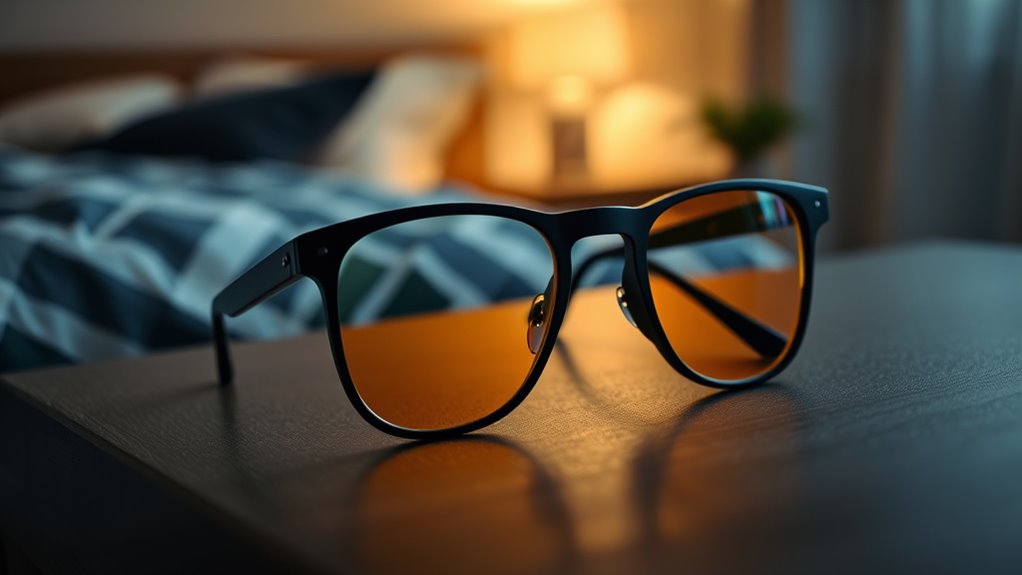
Blue-blocking glasses are just one tool for improving sleep; you might also consider creating darkness in your environment or adjusting your bedtime routines. Cost and accessibility vary compared to other strategies like blackout curtains or limiting screen time, which may be more straightforward or affordable. Combining blue-blocking glasses with good sleep habits can enhance their effectiveness, but understanding how they compare helps you choose the best approach for your needs.
Blue-Blocking Versus Darkness
Compared to simply dimming or darkening your environment, blue-blocking glasses target a specific wavelength of light that can disrupt your circadian rhythm. While darkness reduces overall light exposure, blue-blocking glasses filter out high-energy blue light, which affects melatonin production more directly. This targeted approach helps you maintain a more natural circadian rhythm without needing complete darkness. Additionally, blue-blocking lenses often have a warmer color temperature, which can reduce eye strain caused by harsh screens and artificial lighting. Unlike total darkness, glasses allow you to engage in activities like reading or using devices comfortably while still minimizing blue light exposure. This makes blue-blocking glasses a practical alternative or complement to darkness, especially when complete darkness isn’t feasible.
Cost and Accessibility
Blue-blocking glasses are generally affordable and widely accessible, making them a practical option for improving sleep hygiene. Unlike some strategies, they don’t pose significant cost barriers or accessibility challenges. You can find them at various price points, from budget options to premium brands, fitting different budgets easily. Their availability online and in stores means you can access them without much hassle. Compared to costly sleep devices or professional consultations, blue-blocking glasses are a cost-effective solution. The table below highlights key differences:
| Strategy | Cost and Accessibility |
|---|---|
| Blue-blocking glasses | Affordable, widely available, minimal barriers |
| Light therapy devices | Higher cost, limited access in some areas |
| Sleep coaching or therapy | Often expensive, requires appointments |
| Dark environments | Free, but may require home modifications |
| Sleep tracking gadgets | Varies in cost, sometimes limited availability |
This makes blue-blocking glasses an accessible choice for most.
Complementary Sleep Habits
While blue-blocking glasses are a popular tool for improving sleep, they work best when combined with other healthy sleep habits. Limiting screen time before bed reduces screen fatigue and eye strain, making it easier to wind down. Establishing a consistent sleep schedule helps regulate your circadian rhythm, enhancing the benefits of blue blocking. Creating a relaxing bedtime routine, like reading or gentle stretching, signals your body it’s time to sleep. Avoiding bright screens and caffeine late in the day minimizes disruptions. These habits complement blue-blocking glasses by reducing digital overstimulation and physical discomfort, promoting better sleep quality. Together, these strategies support your circadian alignment and overall sleep hygiene, making your efforts more effective.
Recommendations for Maximizing Benefits
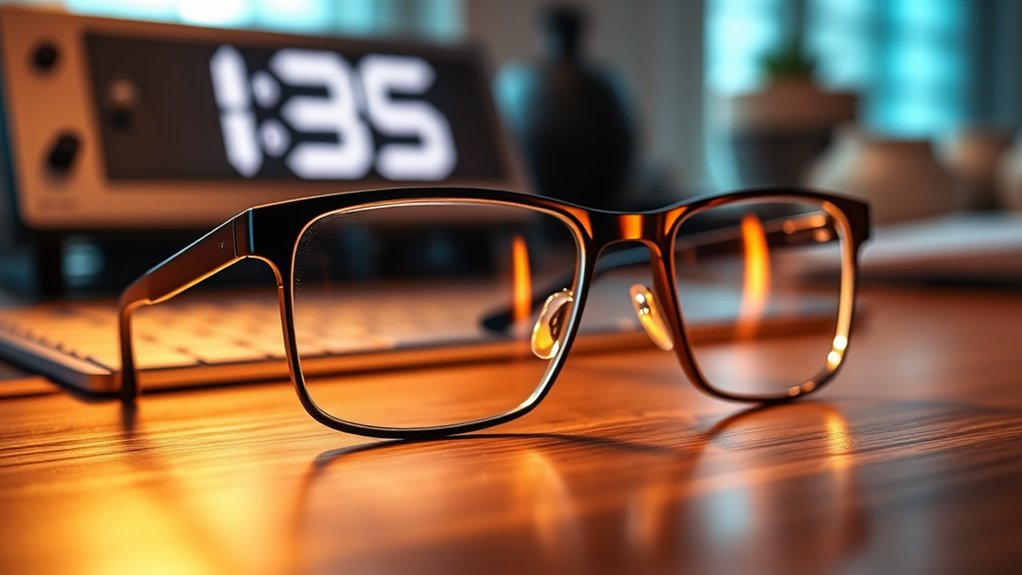
To maximize the benefits of blue-blocking glasses, wearing them consistently during times when you’re exposed to screens or artificial light sources in the evening is vital. Doing so helps protect your eyes from blue light, reducing eye strain and preserving natural color perception. To enhance effectiveness, wear the glasses at least 2-3 hours before bedtime. Adjusting the fit ensures comfort, encouraging regular use. Remember, consistency is key—skipping nights can diminish benefits. Also, pair wearing glasses with other good sleep habits, like dimming lights and reducing screen time. This synergy enhances your circadian alignment without compromising your visual experience or color perception, guaranteeing you get restorative sleep while minimizing eye discomfort.
Potential Side Effects and Considerations
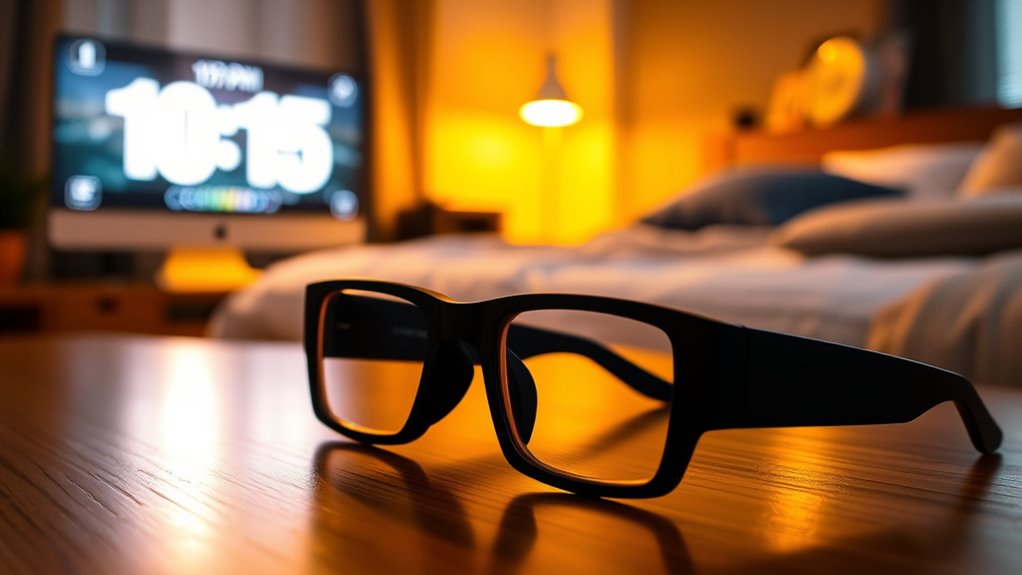
Although blue-blocking glasses are generally safe, some users may experience side effects or discomfort. You might notice increased eye strain or reduced visual comfort, especially if worn for extended periods or in low-light conditions. It’s important to monitor your response and adjust usage accordingly. Potential considerations include:
- Temporary adjustment difficulty, leading to headaches or eye fatigue
- Reduced clarity or color perception, impacting daily tasks
- Overreliance, possibly affecting your ability to adapt to natural light
Being aware of these factors helps you avoid unnecessary discomfort. If you experience persistent eye strain or visual discomfort, consider limiting wearing time or consulting an eye care professional. Proper use ensures you maximize benefits without compromising eye health or comfort.
Future Directions in Blue Light Research
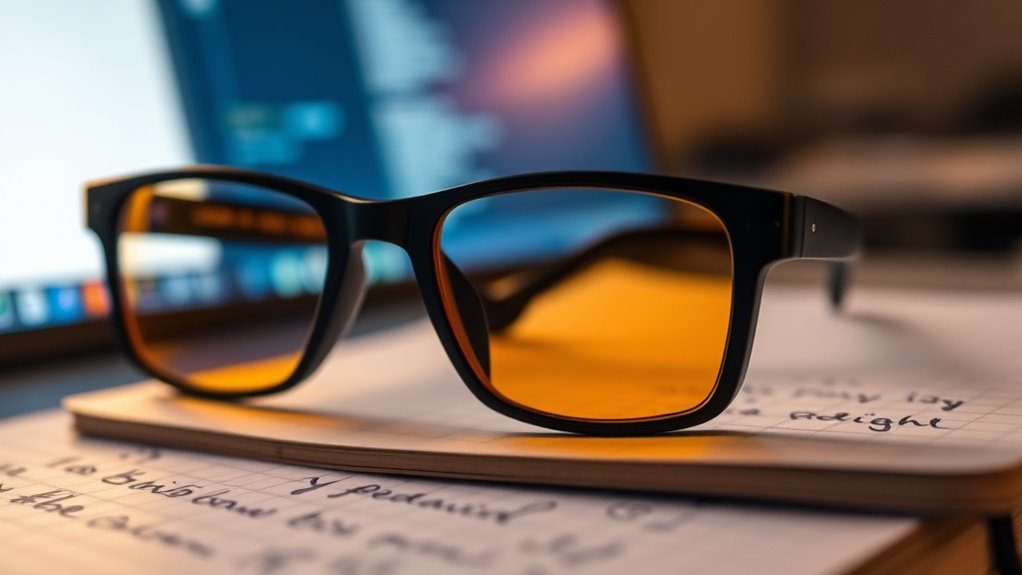
Research on blue light exposure is rapidly advancing, promising to clarify its effects on eye health, sleep, and digital device use. Future research will likely focus on technological innovations that improve blue light filtering methods, making them more effective and user-friendly. As evidence accumulates, regulatory policies may evolve to set standards for blue light emissions from screens and devices, ensuring consumer safety. You can expect more precise studies to determine ideal exposure levels and timing, helping you make informed choices about blue-light management. Additionally, advancements in wearable technology might provide real-time feedback on your blue light exposure, encouraging healthier habits. Overall, these developments aim to balance technological progress with public health, guiding you toward safer digital habits and better circadian health.
Frequently Asked Questions
Are There Specific Brands of Blue-Blocking Glasses Proven More Effective?
When comparing brands, you’ll find some blue‑blocking glasses stand out due to product certifications and independent reviews. Brands like Swanwick, Felix Gray, and Ra Optics often receive positive feedback for durability and effectiveness. While individual preferences vary, checking for certifications such as ANSI or FDA approval can help you choose proven, reliable options. Ultimately, selecting a well-reviewed brand with clear product certifications boosts your chances of effective circadian alignment.
How Quickly Can Users Expect to See Improvements in Sleep Patterns?
Oh, the sweet illusion of instant gratification! You’ll likely notice some sleep improvements within a few days of consistent blue light blocking, but don’t expect miracles overnight. Timeframe expectations vary, and immediate benefits are rare. Usually, it takes about a week or two for your circadian rhythm to realign. Patience, like good wine, is essential—celebrate small wins, and don’t rush the process.
Can Blue-Blocking Glasses Be Beneficial for Children or Teenagers?
You might wonder if blue-blocking glasses can help children or teenagers. They can be beneficial for pediatric sleep by reducing exposure to blue light, which may improve sleep quality and support healthy circadian rhythms. This can also positively influence developmental impacts, such as attention, mood, and learning. While more research is needed, using these glasses in the evening could promote better sleep habits for young people.
Do Blue-Blocking Glasses Interfere With Vitamin D Synthesis?
Did you know that around 42% of adults worldwide have vitamin D deficiency? When you wear blue-blocking glasses, they can reduce blue light exposure, but they don’t block sunlight completely. This means your vitamin D synthesis from sunlight exposure isn’t considerably impacted. So, wearing them shouldn’t interfere with your vitamin D levels, especially if you get regular sunlight. Just make sure to balance screen time with outdoor time!
Are There Any Long-Term Health Risks Associated With Frequent Use?
Considering long-term use of blue-blocking glasses, you might worry about potential eye strain or dependency concerns. While they are generally safe, frequent use could cause your eyes to rely on them, possibly making you less comfortable in normal lighting. However, there’s limited evidence of serious health risks. To avoid issues, use them as needed and take breaks from screens to protect your eye health.
Conclusion
Just as the moon guides the tides, blue-blocking glasses can help guide your circadian rhythm back on track. By reducing evening light exposure, you empower your body’s natural sleep cues, leading to better rest and renewal. Remember, it’s not about blocking all light but harmonizing with nature’s rhythms. Embrace these glasses as your lighthouse in the night, steering you toward healthier sleep and brighter days ahead.
